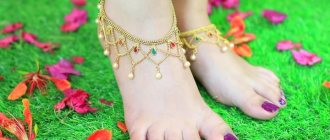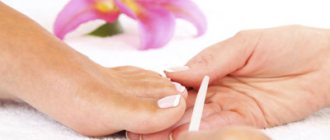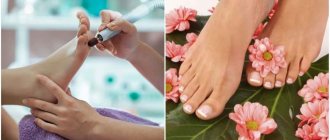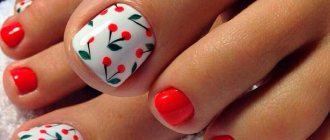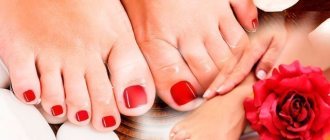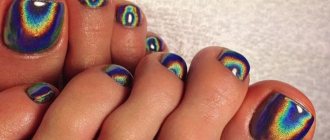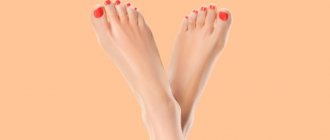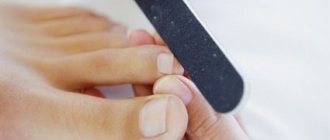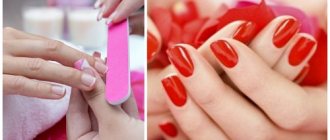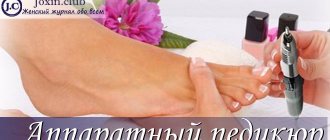Dry pedicure is a foot care procedure without the use of water, scissors or blades. Softening and disinfection of feet and nails is done using antiseptic agents.
Advantages:
- safety – no risk of infection, incl. fungal diseases;
- modern method;
- affordable price;
- high execution speed.
During dry pedicures, water was replaced with disinfectant gels. The cutting tool, which causes minor damage, was completely removed. Exceptionally delicate work. The benefits of dry pedicure have made it a very popular service.
There are two dry pedicure techniques - European and hardware.
For clients with thin, dry, well-groomed skin, experts recommend a European dry pedicure. Suitable for teenagers and children, it will give a flawless and aesthetic look to those with well-groomed feet. The technique is not used in advanced cases; if necessary, it is necessary to reanimate thickened and injured skin. Pedicure according to the European method is gentle on nails and skin. The master actively uses softening compounds, and uses sanding files and polishers to process the skin and cuticles.
Calluses, cracks and corns
– hardware pedicure can effectively cope with these problems. The master carefully processes the delicate skin between the fingers with a milling cutter with special attachments. Hardware pedicure is not recommended for diabetes and for the prevention of fungal diseases.
In beauty centers, professional milling machines with speeds of up to 30,000 rpm are used to treat legs. They provide excellent cuticle treatment, no trauma and predictable results.
How to prepare for a dry pedicure
To prepare your feet for a pedicure, do not soak your feet - use disinfectants that contain additives that protect the skin from drying out. The composition is applied evenly and rubbed until completely dry. The master disinfects his hands and always uses disposable gloves. Files and cutters used repeatedly are constantly sterilized and stored in craft bags or boxes. Cardboard files, polishers, and orange sticks are disposable instruments and are discarded after completion of the procedure.
Therapeutic pedicure for ingrown toenails
Various factors can provoke ingrown toenails in a child - uncomfortable or tight shoes, foot defects, improper nail trimming. A medical pedicure will help effectively solve the problem and prevent relapse. First, the nail is softened with a special product. Then the sharp edges are processed and removed, and capalin, a cotton swab soaked in a medicinal preparation, is placed between the skin and the nail plate. After getting rid of unpleasant symptoms, a correction system (brace or plate) can be installed. It straightens the nail and eliminates the cause of ingrown nails.
Dry European pedicure technology
Are used:
- softening composition;
- orange stick;
- cuticle file;
- nail file;
- cutters of various shapes.
A feature of the European technique is its delicate effect on the cuticle - it is not removed. After softening, the master carefully moves it to the side and processes the nail plate.
If the last pedicure session took 2 months or more, then you should use hardware pedicures, and after treatment, maintain the achieved result using the European technique.
How much does a pedicure cost?
The cost of the procedure is determined by the qualifications of the master and the price of the materials he uses.
On average, a classic pedicure costs from 1,000 rubles. The hardware will cost 1,500 rubles. The price may also be affected by the level of interior. They offer a wide range of pedicure services. In St. Petersburg, the procedure usually does not cost less than 2,000 rubles. At a lower price, you should think about the competence of the specialist, safety and quality of service.
The main stages of work during a European pedicure:
- Feet are treated with disinfectant.
- The polish is removed from the nails.
- The nail plate is adjusted with a file and given the desired length and shape.
- The feet and cuticles are softened using a special product.
- Using an orange stick, the master carefully pushes back the cuticle.
- Feet are treated.
- Using a special nail file, the master delicately grinds down the cuticle and side ridges.
- Use a damp cloth to remove dust.
- The treated areas are disinfected with an antiseptic composition.
- The cuticle is moisturized and treated with nourishing oil.
- A light massage is performed to increase blood circulation in the foot.
At the client's request, the nails are varnished at the final stage.
Advantages of European pedicure:
- painless procedure;
- infection safety;
- with regular use, the thickness of the cuticle decreases, which allows you to use the services of a specialist less often;
- efficiency – the duration of the procedure is no more than 30-40 minutes;
- duration of effect is 2-4 weeks;
- children are allowed;
- affordable price.
European pedicure is not only an excellent effect, but also a practical, relaxing procedure.
Disadvantages of European pedicure:
- not suitable for unkempt feet;
- used only as a maintenance procedure;
- You can achieve a good result only after 3-5 visits to the salon;
- insufficient skin hydration;
- performed more often than a hardware pedicure.
After a European pedicure, feet must be regularly treated with moisturizing and nourishing cosmetics; specific names are recommended by a cosmetologist or podiatrist.
Cuticle removers for safe pedicures
It is quite possible to perform a European pedicure at home or in a salon. This requires special products that soften and remove the cuticle. You can choose one of the following types of compositions:
- Alkaline products that remove cuticles in 3-4 minutes. They should be applied carefully, without overexposure, otherwise you will get a burn on the skin around the nail. The downside is that the growth of the cuticle is greatly accelerated, and, as a result, hangnails appear. Alkaline products require frequent use.
- With aggressive acids. These are professional products, so you won’t find them in ordinary stores. They have a very dense consistency, which allows them to cope with corns and rough skin.
- With fruit acids. The most delicate compositions are in the form of gels. Within 7 minutes, the remover completely removes the cuticle. Thanks to their mild effect, these products can be used every day.
Dry hardware pedicure
The technique is recommended for feet with dry skin, deep cracks and calluses. Suitable for fungal diseases and after completion of treatment.
When working, the master uses a milling cutter, which allows him to effectively process hard-to-reach places between the fingers, and attachments for removing calluses and the deepest cracks. As in European pedicure, softeners and disinfectants are used. To remove rough layers of skin, a scalpel is used, and attachments are used to treat the feet. The nozzles have different abrasiveness, which allows you to gradually and delicately treat the skin. The cuticle is removed with a milling cutter with a diamond attachment. The procedure lasts 30-90 minutes, the treatment time depends on the degree of skin roughness. In complex cases, at least three procedures are recommended at an interval of 3 weeks.
The main stages of hardware pedicure:
- Treatment with a disinfectant.
- Softener treatment.
- Correcting the shape of the nail using a cylindrical diamond cutter.
- Treatment of cuticles and side nozzles.
- Removing the cuticle using the ball attachment.
- Removing calluses and corns using grinding attachments.
- Removing cracks.
- Applying healing ointment to treated cracks.
- Foot polishing.
- Treatment with nourishing lotions.
At the client's request, varnish is applied to the nails at the final stage.
Advantages of hardware pedicure:
- safety, including infectious safety;
- hygiene;
- recommended for problem skin;
- has a pronounced healing effect;
- effectively removes calluses and other skin defects;
- Removes ingrown nails in one procedure.
The effect of a pedicure lasts 3-4 weeks, which is a very good result.
Disadvantages of hardware pedicure:
- if the technician is insufficiently experienced, there is a risk of cutting cuts in the nail;
- hard cuticles can only be dealt with using forceps;
- high requirements for the qualifications of the master;
- not recommended for thin nail plates;
Most of the shortcomings of European and hardware pedicure can be eliminated by combining procedures. At the first visit, a hardware pedicure is recommended, which will help cope with the problems of rough skin. European pedicure is used for support and regular care. An integrated approach gives maximum effect in a short time and minimum costs.
Both types of dry pedicure better prepare your nails for polishing. When the nail plates soften in water, they lose their adhesion. This does not happen when treated with disinfectants; as a result, the nail polish after a dry pedicure lasts a really long time!
European pedicure
– a simple and reliable solution – the skin and nail plate are put in order, the legs acquire proper aesthetics. An excellent choice for summer.
Hardware pedicure
is now a classic and suitable for most clients. Together with a podiatrist, you can choose the appropriate technique.
SPA pedicure or wet
This is another type of European pedicure, which allows you not only to make your legs attractive, but also to enjoy it. To do this procedure yourself at home, you must follow these steps:
- Remove old nail polish. Place your feet in warm water, preferably adding aromatic oils or a little shampoo to make the skin soft.
- Then wipe your feet dry and push back the cuticles using a wooden spatula.
- In order to give your nails the ideal shape, you need to trim them either with nail scissors or tweezers. Use a file to file the edges of your nails so that they are even.
- To remove rough skin on the feet, you can use a special scrub, which is then removed with a soft, damp cloth. After this, a nourishing cream is rubbed into the skin.
- Finish the pedicure by applying bright nail polish.
SPA pedicure or wet
Types of unedged manicure
There are several ways to perform this procedure: from a simple dry Euro manicure to a hardware procedure that requires certain skills.
Techniques for performing European manicure
- dry – performed without using a nail bath;
- wet – before using the remover, the cuticle is soaked in a bath with oils and lotions;
- hot – before removing the pterygium, the nails are immersed in hot cream or lotion. This procedure is recommended for brittle nails and during the cold season;
- Brazilian - to perform a manicure, use special gloves soaked in useful creams and a cuticle softener. Gloves for Brazilian manicure are disposable.
- Before using them, your hands must be treated with an antiseptic.
- Next, put on gloves.
- The pre-creamy mass that is in them needs to be moved to the cuticle area. This is necessary to increase the effectiveness of the procedure.
- After 7 minutes, you need to cut off the tip of the glove on the little finger so that you have access to the cuticle.
- The pterygium is removed with an orange stick.
- While you work with one finger, the rest continue to be saturated with cream and oils.
- After processing one finger, cut off the tip of the glove on the adjacent finger and continue working with the pterygium.
- Work each finger in this way.
- At the end of the procedure, remove gloves and rub the remaining cream into the skin.
For an example of a simple unedged manicure, see the video.
You will learn more about hot manicure by watching the video.
Watch all the stages of a Brazilian manicure in the video tutorial.
Varieties
In the Shimada beauty salons in Koptevo and Mitino, foot care methods are selected individually. In general, there are several types of female pedicure:
- classical;
- hardware;
- mixed;
- medical;
- European.
During a classic pedicure, preliminary steaming of the feet is performed. Then they are cleaned, the cuticle is removed, the nails are shaped into the desired shape and the nail plates are polished. If desired, nails are varnished. The hardware method differs from the classical one in that a special apparatus is used instead of the usual tools. With its help, the master carefully performs a full range of services. Mixed female pedicure combines the first two types. The medical method allows you to cope with various pathological conditions of the feet (ingrown toenails, fungus). The softest and most gentle is the European pedicure.
Pedicure for injuries and deformations of nails
Excessive activity in children often leads to nail injury. To relieve inflammation and pain, the podologist will prescribe a safe and effective treatment, which includes a medical pedicure. During the procedure, damaged parts of the nail are removed, and healthy parts are treated with an antiseptic. If necessary, the podologist can install a bracket or plate to correct the nail plate or recommend prosthetics - installing an artificial nail that will look very natural.
Hygienic treatment of feet for sweaty feet
When wearing socks or tights that contain synthetics, improper selection of shoes, or metabolic disorders, children may suffer from increased sweating of the feet.
The doctor will select an effective treatment method taking into account the child’s age and the cause of the disease. Therapeutic pedicure is important in the treatment of hyperhidrosis. The feet are treated with cleansing and disinfecting agents that eliminate the smell of sweat and prevent the development of bacteria. If necessary, the podologist will recommend contacting an endocrinologist or cardiologist.
Features of medical pedicure for children of different ages
In children under 7 years of age, the nail plates are thin and elastic. Therefore, it is not recommended to process them with a nail file. Children's nails are cut strictly in a straight line, softening the sharp corners.
In children over 7 years of age, the nail plate thickens. Therefore, nails are carefully treated with a nail file.
Benefits of untrimmed pedicure
When working with children, specialists at the Podology Clinic often use European unedged (hardware) pedicure, which focuses on atraumatic methods of treating the skin of the feet, cuticles, and side ridges.
Hardware processing has several advantages:
- does not cause pain;
- does not injure healthy tissue;
- characterized by a high processing speed, which is especially important for children, since they are very mobile and cannot sit still for a long time;
- provides a long-lasting effect - nails retain a well-groomed appearance for a long time;
- has no contraindications.
At the Podology Clinic, when performing children's therapeutic pedicures, only gentle instruments and hypoallergenic care products made from safe natural ingredients are used.
If your child has problems with their feet, contact the Podiatry Clinic. Experienced specialists will provide professional assistance to maintain the health and beauty of your child’s feet.
Pedicure for nail fungus
Treatment for fungus is prescribed by a podologist or dermatologist. A medical pedicure will speed up recovery, slow down the spread of infection and give your nails an aesthetic appearance.
Before starting the procedure, the affected areas are disinfected and softened using special preparations. Then the top layer of the nail plate is removed with special cutters, and healthy areas are treated with antifungal ointments. To get the perfect result, you need to carry out several procedures.
Tools
To perform the procedure in full, the following tools are used in the Shimada beauty salons in Mitino and Koptevo:
- Nippers are a universal tool that is used to remove hangnails, cuticles, and corners of nails. We only use stainless steel nippers, as this material is the most durable and strong.
- Tweezers are multifunctional tools. With their help, problematic or dead areas of the dermis are removed and nails are trimmed.
- Scissors - designed to correct the length of nail plates.
- Blade - used in the presence of very rough skin. Used only when other methods of dealing with the problem are ineffective.
- Pusher - used to separate the cuticle. In addition, with its help, ingrown nails are pulled out and growths are cleared.
- Pumice stone - cleanses the skin of the feet from corns, calluses and rough areas. Use only after preliminary steaming of the feet.
The best hairdressers in Moscow work in the Simada beauty salons in Mitino and Koptevo. In their work, they use only premium materials, which guarantees high quality and long-term preservation of the results after performing a female pedicure.
Information about current promotions and current prices for hardware, edged and other types of women's pedicures are presented on the website of the Shimada beauty salons in Koptevo and Mitino. You can learn more about the procedure, as well as sign up for a women’s pedicure by phone or through the feedback form on our portal.
